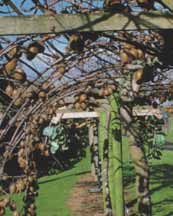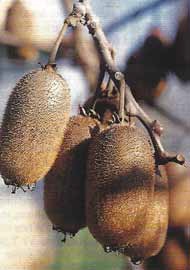
| What is Flavor and Fortune? |
| How do I subscribe? |
| How do I get past issues? |
| How do I advertise? |
| How do I contact the editor? |
Read 12931522 times
Connect me to:
| Home |
| Articles |
| Book reviews |
| Letters to the Editor |
| Newmans News and Notes |
| Recipes |
| Restaurant reviews |
| Article Index (all years, slow) |
| List of Article Years |
| Article Index (2025) |
| Article Index (last 2 years) |
| Things others say |
| Related Links |
| Log In... |
| Authors |
| Categories & Topics |
Kiwi: Gooseberry is Still a Yang-Tao
| by Jacqueline M. Newman |
Fruits, Desserts, and Other Sweet Foods
Winter Volume: 2018 Issue: 25(4) page(s): 15
This fruit with its brown fuzzy exterior was only bright green inside with many small black seeds within. Originating in China growing wild there in the Yangtze valley, there are many new kiwi colors grown commercially there and in Australia, Chili, France, Italy, Japan, New Zealand, Taiwan, and the United States. They can now be other colors, light to bright, and still with fuzzy brown exteriors that now can be tan to brown. They often hang from branches nailed across poles like soldiers lined and at attention. They can be sweet, are still loaded with dark seeds and Vitamins C, E, and K, also minerals copper, folate, manganese, and potassium; they do have lots of fiber.

Botanically called Actinidia deliciosa, these fruits have many phytonutrients that protect cell nuclei and DNA; and eating them helps staying well because they have many anti-oxidants, amounts needed as yet not determined. They grow on poles with cross-bars giving them lots of room and air to flourish.
TCM practitioners frequently recommend the tao for children with asthma, their elders needing heart health, also folks of all ages needing polyl-phenol components thought valuable for all.
Originally, these fruits were from China, they went to New Zealand with missionaries and there were renamed for New Zealand’s flightless bird, the kiwi. With enzymes under their skins, these fruits are excellent meat tenderizers. New and colorful fruits include new varieties from light tan, golden/yellow, to red, and beyond. All are varieties of the green ones from China.

When ripe, these fruits yield to the touch similar to ripe pears, are best stored at room temperature, and they keep that way for at least ten days. We read some call them ‘Macaque Peaches’ because of their shape and color, and that local monkeys like to eat them. TCM medical practitioners recommend them to get rid of excessive heat, expel extreme thirst, reduce irritability, regulate Qi, relieve joint pain due to rheumatism, and assist digestion.
The trees or wood cross beams they grow on, as shown below, can have fragile branches. These grow to about thirty feet, when ground their roots make good pesticides. They have fibers useful for making paper, sap that makes good glue, leaves that most livestock likes to consume, oils that can add flavor to many foods, juices to make wine, and seeds popular for making those oils. When growing wild, they are hen-egg size or smaller, and were called yangtaw. Recently they have a new botanical name, mihutao. They are also known as tengli which means ‘vine pear’, and they grow sweeter if left on their trees longer and not picked too early.
There is a push to improve available varieties in many countries, so collecting the wild seeds does increase hope for the future. Some expect that will happen at the new kiwi research center in the Sichuan Province or in New Zealand, China, or Taiwan.
Some believe China has an advantage as they already have many wild varieties, but they do not have expertise in commercialization of this fruit. If all are willing to cooperate maybe China’s red kiwi with a honey flavor will hit the market before any sets of researchers working together will. No one is sure as there are secrecy regulations. Taiwan has also entered this market.
There is a current struggle for increased kiwi production, no matter its color. Taiwan does not have any wild varieties and can not gain claim to those in China. New Zealand would love to introduce a new variety but some say they can not unless they steal or buy them. Time will tell who might be the first country to do so.
This brown original fuzzy fruit on the exterior has many black seeds in its interior. Once known as a gooseberry or a yang taw before renaming it for today’s market. There is now a huge increase in sales and consumption after the new nomenclature and marketing blitz that made this wild and virtually unknown fruit make meg-millions of money.
It originated in China as a wild tree fruit known in their language as yang taw or mihoutao, also a teng li or vine pears. It did grow wild and mostly in the Yangtze valley. Now it is grown there and in also Australia, France, Italy, New Zealand Taiwan, and several South American countries.
| Local Meatballs |
|---|
1 pound fatty pork, minced
1. Mix minced pork, shrimp, mushrooms, onion, and
water chestnuts.
|
| Sweet and Sour Vegetables |
|---|
11 large green-fruited kiwi, peeled and cut in large cubes
1. Mix kwi pieces and cornstarch.
|

Copyright © 1994-2025 by ISACC, all rights reserved
Address
3 Jefferson Ferry Drive
S. Setauket NY 11720